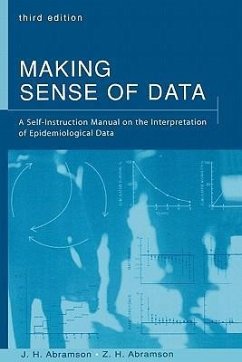J. H. Abramson, Z. H. Abramson
Making Sense of Data
A Self-Instruction Manual on the Interpretation of Epidemiological Data
J. H. Abramson, Z. H. Abramson
Making Sense of Data
A Self-Instruction Manual on the Interpretation of Epidemiological Data
- Broschiertes Buch
- Merkliste
- Auf die Merkliste
- Bewerten Bewerten
- Teilen
- Produkt teilen
- Produkterinnerung
- Produkterinnerung
This self-instructional manual on the interpretation and use of epidemiologic data deals with the basic concepts and skills needed for the appraisal of published reports or one's own findings. Applications in clinical medicine, public health, community medicine, and research are all taken into consideration. Making Sense of Data is designed as a workbook of short exercises and instructional self-tests that introduce fundamental approaches and procedures in data interpretation and develop competency in working with epidemiologic tools. Basic concepts are presented in the first section, which…mehr
Andere Kunden interessierten sich auch für
![The Sense of Taste The Sense of Taste]() Petra SchlingThe Sense of Taste18,99 €
Petra SchlingThe Sense of Taste18,99 €![The Dry-fly Man's Handbook; a Complete Manual, Including The Fisherman's Entomology and the Making and Management of a Fishery The Dry-fly Man's Handbook; a Complete Manual, Including The Fisherman's Entomology and the Making and Management of a Fishery]() Frederic M. HalfordThe Dry-fly Man's Handbook; a Complete Manual, Including The Fisherman's Entomology and the Making and Management of a Fishery43,99 €
Frederic M. HalfordThe Dry-fly Man's Handbook; a Complete Manual, Including The Fisherman's Entomology and the Making and Management of a Fishery43,99 €![Dictionary of Insect Morphology Dictionary of Insect Morphology]() Henrik SteinmannDictionary of Insect Morphology253,99 €
Henrik SteinmannDictionary of Insect Morphology253,99 €![A Dictionary of Biology A Dictionary of Biology]() A Dictionary of Biology23,99 €
A Dictionary of Biology23,99 €![Sustaining Life Sustaining Life]() Sustaining Life80,99 €
Sustaining Life80,99 €![Fluid Dynamics Fluid Dynamics]() Anatoly RubanFluid Dynamics98,99 €
Anatoly RubanFluid Dynamics98,99 €![Evolutionary Ecology of Marine Invertebrate Larvae Evolutionary Ecology of Marine Invertebrate Larvae]() Evolutionary Ecology of Marine Invertebrate Larvae164,99 €
Evolutionary Ecology of Marine Invertebrate Larvae164,99 €-
-
-
This self-instructional manual on the interpretation and use of epidemiologic data deals with the basic concepts and skills needed for the appraisal of published reports or one's own findings. Applications in clinical medicine, public health, community medicine, and research are all taken into consideration. Making Sense of Data is designed as a workbook of short exercises and instructional self-tests that introduce fundamental approaches and procedures in data interpretation and develop competency in working with epidemiologic tools. Basic concepts are presented in the first section, which also demonstrates the step-by-step assessment of data. The next section discusses rates and other simple measures, and the third shows how to judge their accuracy. Section IV and V deal with more complex issues of associations between variables and the appraisal of cause-effect relationships. Section VI deals with meta-analysis (the critical review and integration of the findings from separate studies) and section VII with the questions to be asked before deciding to apply study results in practice. Numerous changes have been made in this edition, including the addition of a section on the practical application of epidemiological findings, discussions of new topics (Cox proportional hazards regression, qualitative studies, ROC curves), and fresh examples.
Hinweis: Dieser Artikel kann nur an eine deutsche Lieferadresse ausgeliefert werden.
Hinweis: Dieser Artikel kann nur an eine deutsche Lieferadresse ausgeliefert werden.
Produktdetails
- Produktdetails
- Verlag: Oxford University Press
- 3. Auflage
- Seitenzahl: 384
- Erscheinungstermin: 1. September 2001
- Englisch
- Abmessung: 234mm x 156mm x 21mm
- Gewicht: 582g
- ISBN-13: 9780195145250
- ISBN-10: 0195145259
- Artikelnr.: 21043454
- Herstellerkennzeichnung
- Libri GmbH
- Europaallee 1
- 36244 Bad Hersfeld
- gpsr@libri.de
- Verlag: Oxford University Press
- 3. Auflage
- Seitenzahl: 384
- Erscheinungstermin: 1. September 2001
- Englisch
- Abmessung: 234mm x 156mm x 21mm
- Gewicht: 582g
- ISBN-13: 9780195145250
- ISBN-10: 0195145259
- Artikelnr.: 21043454
- Herstellerkennzeichnung
- Libri GmbH
- Europaallee 1
- 36244 Bad Hersfeld
- gpsr@libri.de
* Introduction
* The aim of the book
* How to use the book
* A. Basic Concepts and Procedures
* A1: Introduction
* A2: Determining what the facts are, Summarizing the facts
* A3: Absolute and relative differences
* A4: Diagrams
* A5: Seeking explanations for the facts, Testing explanations
* A6: The basic scientific process, Rates
* A7: Rates (continued), Inspecting a two-dimensional table
* A8: Inspecting a two-dimensional table (continued)
* A9: Inspecting a two-dimensional table (continued), Associations
* A10: Associations (continued), Confounding
* A11: Confounding (continued), Effect modification
* A12: Refinement, skeleton tables, Elaborating an association
* A13: Modifying and confounding effects
* A14: Elaborating an association (continued)
* A15: The use of rates, Causal explanations, Testing causal
explanations
* A16: Testing causal explanations (continued, Basic procedure for
appraisal of data, What are the facts? What are the possible
explanations? What additional information is required?
* A17: Uses of epidemiological data
* A18: Test yourself (A)
* B. Rates and Other Measures
* B1: Introduction, What is a rate? Prevalence rates
* B2: Prevalence rates (continued)
* B3: Questions about a rate, What kind of rate is it? Of what is it a
rate? To what population or group does the rate refer? How was the
information obtained?
* B4: Sources of bias, Confidence interval, Validity, Qualitative
studies
* B5: Use of prevalence data, Incidence rates
* B6: Incidence rates (continued)
* B7: Bias in incidence studies
* B8: Uses of incidence rates
* B9: Estimating the individual's chances, Time to event (survival
time)
* B10: Estimating the individual's chances (continued), Other rates,
What are the odds?
* B11: Other rates (continued), Odds ratio
* B12: Other measures
* B13: Indirect standardization
* B14: Indirect standardization (continued), Direct standardization
* B15: The use of standardized rates
* B16: Test yourself (B)
* C. How Good Are the Measures?
* C1: Introduction
* C2: Validity of a measure, Sensitivity and specificity
* C3: Misclassification
* C4: Differential misclassification
* C5: Effects of misclassification
* C6: Effects of misclassification (continued)
* C7: Other ways of appraising validity, Reliability
* C8: Appraisal of reliability
* C9: Appraisal of reliability (continued), Regression towards the
mean, Taking account of validity and reliability, Screening tests
* C10: Appraisal of a screening test
* C11: Appraisal of a screening test (continued)
* C12: Appraisal of diagnostic tests, ROC curves, The meaning of
"normal"
* C13: Test yourself (C)
* D. Making Sense of Associations
* D1: Introduction
* D2: Explanations for an association
* D3: Effects of misclassification, Statistical significance
* D4: Statistical significance (continued)
* D5: Confounding effects
* D6: Confounding effects (continued)
* D7: Multivariate analysis
* D8: Explanations for the findings, Risk factors and risk markers,
Appraising a risk marker, Uses of the findings
* D9: Risk factors and risk markers (continued), Measures of the
strength of an association
* D10: Measures of strength
* D11: Measures of strength (continued), Matched samples
* D12: Synergism
* D13: Appraising stratified data, Making sense of multivariate
analysis
* D14: Multiple logistic regression
* D15: Multiple logistic regression (continued)
* D16: Proportional hazards regression
* D17: Multiple linear regression
* D18: Test yourself (D)
* E. Causes and Effects
* E1: Introduction, Kinds of Study
* E2: Appraising the results of a cross-sectional study
* E3: Appraising the results of a case-control study
* E4: Appraising the results of a cohort study
* E5: Appraising the results of a group-based study
* E6: Appraising the results of an experiment
* E7: Appraising the results of a quasi-experiment
* E8: Artifact, confounding or cause?
* E9: Coping with confounding, Delving into causes
* E10: Evidence for a causal relationship
* E11: Evidence for a causal relationship (continued), The impact of a
causal factor
* E12: The attributable fraction
* E13: Prevented and preventable fractions
* E14: Test yourself (E)
* F. Meta-Analysis: Putting It All Together
* F1: Introduction
* F2: The scope of meta-analysis
* F3: Measures used in meta-analysis
* F4: Measures used in meta-analysis (continued), Basic information
* F5: Finding the studies
* F6: Selecting studies
* F7: The quality of the studies, Extracting the findings, Apples and
oranges
* F8: Appraising combinability, Explaining heterogeneity
* F9: Explaining heterogeneity (continued)
* F10: Effect modification
* F11: Using the results, Evaluating a meta-analysis
* F12: Test yourself (F)
* G. Putting Study Findings to Use
* G1: Introduction
* G2: Are the results accurately known
* G3: Validity of the findings
* G4: Relevance of the findings
* G5: Expected effects
* G6: Feasibility and cost
* G7: Test yourself (G)
* References
* Index
* The aim of the book
* How to use the book
* A. Basic Concepts and Procedures
* A1: Introduction
* A2: Determining what the facts are, Summarizing the facts
* A3: Absolute and relative differences
* A4: Diagrams
* A5: Seeking explanations for the facts, Testing explanations
* A6: The basic scientific process, Rates
* A7: Rates (continued), Inspecting a two-dimensional table
* A8: Inspecting a two-dimensional table (continued)
* A9: Inspecting a two-dimensional table (continued), Associations
* A10: Associations (continued), Confounding
* A11: Confounding (continued), Effect modification
* A12: Refinement, skeleton tables, Elaborating an association
* A13: Modifying and confounding effects
* A14: Elaborating an association (continued)
* A15: The use of rates, Causal explanations, Testing causal
explanations
* A16: Testing causal explanations (continued, Basic procedure for
appraisal of data, What are the facts? What are the possible
explanations? What additional information is required?
* A17: Uses of epidemiological data
* A18: Test yourself (A)
* B. Rates and Other Measures
* B1: Introduction, What is a rate? Prevalence rates
* B2: Prevalence rates (continued)
* B3: Questions about a rate, What kind of rate is it? Of what is it a
rate? To what population or group does the rate refer? How was the
information obtained?
* B4: Sources of bias, Confidence interval, Validity, Qualitative
studies
* B5: Use of prevalence data, Incidence rates
* B6: Incidence rates (continued)
* B7: Bias in incidence studies
* B8: Uses of incidence rates
* B9: Estimating the individual's chances, Time to event (survival
time)
* B10: Estimating the individual's chances (continued), Other rates,
What are the odds?
* B11: Other rates (continued), Odds ratio
* B12: Other measures
* B13: Indirect standardization
* B14: Indirect standardization (continued), Direct standardization
* B15: The use of standardized rates
* B16: Test yourself (B)
* C. How Good Are the Measures?
* C1: Introduction
* C2: Validity of a measure, Sensitivity and specificity
* C3: Misclassification
* C4: Differential misclassification
* C5: Effects of misclassification
* C6: Effects of misclassification (continued)
* C7: Other ways of appraising validity, Reliability
* C8: Appraisal of reliability
* C9: Appraisal of reliability (continued), Regression towards the
mean, Taking account of validity and reliability, Screening tests
* C10: Appraisal of a screening test
* C11: Appraisal of a screening test (continued)
* C12: Appraisal of diagnostic tests, ROC curves, The meaning of
"normal"
* C13: Test yourself (C)
* D. Making Sense of Associations
* D1: Introduction
* D2: Explanations for an association
* D3: Effects of misclassification, Statistical significance
* D4: Statistical significance (continued)
* D5: Confounding effects
* D6: Confounding effects (continued)
* D7: Multivariate analysis
* D8: Explanations for the findings, Risk factors and risk markers,
Appraising a risk marker, Uses of the findings
* D9: Risk factors and risk markers (continued), Measures of the
strength of an association
* D10: Measures of strength
* D11: Measures of strength (continued), Matched samples
* D12: Synergism
* D13: Appraising stratified data, Making sense of multivariate
analysis
* D14: Multiple logistic regression
* D15: Multiple logistic regression (continued)
* D16: Proportional hazards regression
* D17: Multiple linear regression
* D18: Test yourself (D)
* E. Causes and Effects
* E1: Introduction, Kinds of Study
* E2: Appraising the results of a cross-sectional study
* E3: Appraising the results of a case-control study
* E4: Appraising the results of a cohort study
* E5: Appraising the results of a group-based study
* E6: Appraising the results of an experiment
* E7: Appraising the results of a quasi-experiment
* E8: Artifact, confounding or cause?
* E9: Coping with confounding, Delving into causes
* E10: Evidence for a causal relationship
* E11: Evidence for a causal relationship (continued), The impact of a
causal factor
* E12: The attributable fraction
* E13: Prevented and preventable fractions
* E14: Test yourself (E)
* F. Meta-Analysis: Putting It All Together
* F1: Introduction
* F2: The scope of meta-analysis
* F3: Measures used in meta-analysis
* F4: Measures used in meta-analysis (continued), Basic information
* F5: Finding the studies
* F6: Selecting studies
* F7: The quality of the studies, Extracting the findings, Apples and
oranges
* F8: Appraising combinability, Explaining heterogeneity
* F9: Explaining heterogeneity (continued)
* F10: Effect modification
* F11: Using the results, Evaluating a meta-analysis
* F12: Test yourself (F)
* G. Putting Study Findings to Use
* G1: Introduction
* G2: Are the results accurately known
* G3: Validity of the findings
* G4: Relevance of the findings
* G5: Expected effects
* G6: Feasibility and cost
* G7: Test yourself (G)
* References
* Index
* Introduction
* The aim of the book
* How to use the book
* A. Basic Concepts and Procedures
* A1: Introduction
* A2: Determining what the facts are, Summarizing the facts
* A3: Absolute and relative differences
* A4: Diagrams
* A5: Seeking explanations for the facts, Testing explanations
* A6: The basic scientific process, Rates
* A7: Rates (continued), Inspecting a two-dimensional table
* A8: Inspecting a two-dimensional table (continued)
* A9: Inspecting a two-dimensional table (continued), Associations
* A10: Associations (continued), Confounding
* A11: Confounding (continued), Effect modification
* A12: Refinement, skeleton tables, Elaborating an association
* A13: Modifying and confounding effects
* A14: Elaborating an association (continued)
* A15: The use of rates, Causal explanations, Testing causal
explanations
* A16: Testing causal explanations (continued, Basic procedure for
appraisal of data, What are the facts? What are the possible
explanations? What additional information is required?
* A17: Uses of epidemiological data
* A18: Test yourself (A)
* B. Rates and Other Measures
* B1: Introduction, What is a rate? Prevalence rates
* B2: Prevalence rates (continued)
* B3: Questions about a rate, What kind of rate is it? Of what is it a
rate? To what population or group does the rate refer? How was the
information obtained?
* B4: Sources of bias, Confidence interval, Validity, Qualitative
studies
* B5: Use of prevalence data, Incidence rates
* B6: Incidence rates (continued)
* B7: Bias in incidence studies
* B8: Uses of incidence rates
* B9: Estimating the individual's chances, Time to event (survival
time)
* B10: Estimating the individual's chances (continued), Other rates,
What are the odds?
* B11: Other rates (continued), Odds ratio
* B12: Other measures
* B13: Indirect standardization
* B14: Indirect standardization (continued), Direct standardization
* B15: The use of standardized rates
* B16: Test yourself (B)
* C. How Good Are the Measures?
* C1: Introduction
* C2: Validity of a measure, Sensitivity and specificity
* C3: Misclassification
* C4: Differential misclassification
* C5: Effects of misclassification
* C6: Effects of misclassification (continued)
* C7: Other ways of appraising validity, Reliability
* C8: Appraisal of reliability
* C9: Appraisal of reliability (continued), Regression towards the
mean, Taking account of validity and reliability, Screening tests
* C10: Appraisal of a screening test
* C11: Appraisal of a screening test (continued)
* C12: Appraisal of diagnostic tests, ROC curves, The meaning of
"normal"
* C13: Test yourself (C)
* D. Making Sense of Associations
* D1: Introduction
* D2: Explanations for an association
* D3: Effects of misclassification, Statistical significance
* D4: Statistical significance (continued)
* D5: Confounding effects
* D6: Confounding effects (continued)
* D7: Multivariate analysis
* D8: Explanations for the findings, Risk factors and risk markers,
Appraising a risk marker, Uses of the findings
* D9: Risk factors and risk markers (continued), Measures of the
strength of an association
* D10: Measures of strength
* D11: Measures of strength (continued), Matched samples
* D12: Synergism
* D13: Appraising stratified data, Making sense of multivariate
analysis
* D14: Multiple logistic regression
* D15: Multiple logistic regression (continued)
* D16: Proportional hazards regression
* D17: Multiple linear regression
* D18: Test yourself (D)
* E. Causes and Effects
* E1: Introduction, Kinds of Study
* E2: Appraising the results of a cross-sectional study
* E3: Appraising the results of a case-control study
* E4: Appraising the results of a cohort study
* E5: Appraising the results of a group-based study
* E6: Appraising the results of an experiment
* E7: Appraising the results of a quasi-experiment
* E8: Artifact, confounding or cause?
* E9: Coping with confounding, Delving into causes
* E10: Evidence for a causal relationship
* E11: Evidence for a causal relationship (continued), The impact of a
causal factor
* E12: The attributable fraction
* E13: Prevented and preventable fractions
* E14: Test yourself (E)
* F. Meta-Analysis: Putting It All Together
* F1: Introduction
* F2: The scope of meta-analysis
* F3: Measures used in meta-analysis
* F4: Measures used in meta-analysis (continued), Basic information
* F5: Finding the studies
* F6: Selecting studies
* F7: The quality of the studies, Extracting the findings, Apples and
oranges
* F8: Appraising combinability, Explaining heterogeneity
* F9: Explaining heterogeneity (continued)
* F10: Effect modification
* F11: Using the results, Evaluating a meta-analysis
* F12: Test yourself (F)
* G. Putting Study Findings to Use
* G1: Introduction
* G2: Are the results accurately known
* G3: Validity of the findings
* G4: Relevance of the findings
* G5: Expected effects
* G6: Feasibility and cost
* G7: Test yourself (G)
* References
* Index
* The aim of the book
* How to use the book
* A. Basic Concepts and Procedures
* A1: Introduction
* A2: Determining what the facts are, Summarizing the facts
* A3: Absolute and relative differences
* A4: Diagrams
* A5: Seeking explanations for the facts, Testing explanations
* A6: The basic scientific process, Rates
* A7: Rates (continued), Inspecting a two-dimensional table
* A8: Inspecting a two-dimensional table (continued)
* A9: Inspecting a two-dimensional table (continued), Associations
* A10: Associations (continued), Confounding
* A11: Confounding (continued), Effect modification
* A12: Refinement, skeleton tables, Elaborating an association
* A13: Modifying and confounding effects
* A14: Elaborating an association (continued)
* A15: The use of rates, Causal explanations, Testing causal
explanations
* A16: Testing causal explanations (continued, Basic procedure for
appraisal of data, What are the facts? What are the possible
explanations? What additional information is required?
* A17: Uses of epidemiological data
* A18: Test yourself (A)
* B. Rates and Other Measures
* B1: Introduction, What is a rate? Prevalence rates
* B2: Prevalence rates (continued)
* B3: Questions about a rate, What kind of rate is it? Of what is it a
rate? To what population or group does the rate refer? How was the
information obtained?
* B4: Sources of bias, Confidence interval, Validity, Qualitative
studies
* B5: Use of prevalence data, Incidence rates
* B6: Incidence rates (continued)
* B7: Bias in incidence studies
* B8: Uses of incidence rates
* B9: Estimating the individual's chances, Time to event (survival
time)
* B10: Estimating the individual's chances (continued), Other rates,
What are the odds?
* B11: Other rates (continued), Odds ratio
* B12: Other measures
* B13: Indirect standardization
* B14: Indirect standardization (continued), Direct standardization
* B15: The use of standardized rates
* B16: Test yourself (B)
* C. How Good Are the Measures?
* C1: Introduction
* C2: Validity of a measure, Sensitivity and specificity
* C3: Misclassification
* C4: Differential misclassification
* C5: Effects of misclassification
* C6: Effects of misclassification (continued)
* C7: Other ways of appraising validity, Reliability
* C8: Appraisal of reliability
* C9: Appraisal of reliability (continued), Regression towards the
mean, Taking account of validity and reliability, Screening tests
* C10: Appraisal of a screening test
* C11: Appraisal of a screening test (continued)
* C12: Appraisal of diagnostic tests, ROC curves, The meaning of
"normal"
* C13: Test yourself (C)
* D. Making Sense of Associations
* D1: Introduction
* D2: Explanations for an association
* D3: Effects of misclassification, Statistical significance
* D4: Statistical significance (continued)
* D5: Confounding effects
* D6: Confounding effects (continued)
* D7: Multivariate analysis
* D8: Explanations for the findings, Risk factors and risk markers,
Appraising a risk marker, Uses of the findings
* D9: Risk factors and risk markers (continued), Measures of the
strength of an association
* D10: Measures of strength
* D11: Measures of strength (continued), Matched samples
* D12: Synergism
* D13: Appraising stratified data, Making sense of multivariate
analysis
* D14: Multiple logistic regression
* D15: Multiple logistic regression (continued)
* D16: Proportional hazards regression
* D17: Multiple linear regression
* D18: Test yourself (D)
* E. Causes and Effects
* E1: Introduction, Kinds of Study
* E2: Appraising the results of a cross-sectional study
* E3: Appraising the results of a case-control study
* E4: Appraising the results of a cohort study
* E5: Appraising the results of a group-based study
* E6: Appraising the results of an experiment
* E7: Appraising the results of a quasi-experiment
* E8: Artifact, confounding or cause?
* E9: Coping with confounding, Delving into causes
* E10: Evidence for a causal relationship
* E11: Evidence for a causal relationship (continued), The impact of a
causal factor
* E12: The attributable fraction
* E13: Prevented and preventable fractions
* E14: Test yourself (E)
* F. Meta-Analysis: Putting It All Together
* F1: Introduction
* F2: The scope of meta-analysis
* F3: Measures used in meta-analysis
* F4: Measures used in meta-analysis (continued), Basic information
* F5: Finding the studies
* F6: Selecting studies
* F7: The quality of the studies, Extracting the findings, Apples and
oranges
* F8: Appraising combinability, Explaining heterogeneity
* F9: Explaining heterogeneity (continued)
* F10: Effect modification
* F11: Using the results, Evaluating a meta-analysis
* F12: Test yourself (F)
* G. Putting Study Findings to Use
* G1: Introduction
* G2: Are the results accurately known
* G3: Validity of the findings
* G4: Relevance of the findings
* G5: Expected effects
* G6: Feasibility and cost
* G7: Test yourself (G)
* References
* Index








